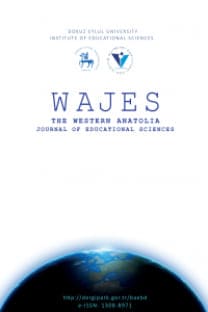İngilizce Öğretmen Adaylarının Türkiye’de Öğretmenlik Mesleğini Kariyer Olarak Nasıl Algıladıkları Gerçeği: Bulguların Analizi
İngilizce öğretmen adayları, öğretmenlik mesleği, algılar, kariyer seçimi
Prospective English Language Teachers' Attitudes to Teaching as A Career in Turkey: A Critical Analysis of Findings
English language teachers, teaching profession, perceptions, career choice,
___
- Alexander, D., Chant, D., & Cox, B. (1994). What motivates people to become teachers. Australian Journal of Teacher Education, 19(2), 40-49.
- Akintomide, G., &Oluwatosin, A. (2011). TeacherCharacteristicsandStudents’ Choice of Teaching as a Career in Osun State. EdoJournal of Counselling, 4 (2), 116-129.
- Bastick, T.A motivation model describing the career choice of teacher trainees in Jamaica. Paper presented at the Biennual Conference of the International Study Association on Teachers and Teaching, July 1999, Dublin.
- Brown, M. M. (1992). Carribean first-year teachers’ reasons for choosing teaching as a career. Journal of Education for Teaching, 18, 185-195.
- Chivore, B. S. R. (1988). A Review of factors that determine the attractiveness of teaching profession in Zimbabwe. International Review of Education, 34(1), 59-77.
- Chuene, K., Lubben, F., &Newson, G. (1999). The views of pre-service and novice teachers on mathematics teaching in South Africa related to their educational experience. Educational Research, 41, 23-34.
- Feeney, S., & R. Chun. (1985). Effectiveteachers of youngchildren. YoungChildren, 41 (1), 47–52.
- Isenberg, J. P. (1990). Teachers' thinking and beliefs and classroom practice. Childhood Education, 66, 322-327.
- Johnson, S. M., &Birkeland, S. E. (2003). Pursuing a Sense of Success: new teachers explain their career decisions. American Educational Research Journal, 40(3), 581-617.
- Johnston, J., McKeown, E., & McEwan, A. (1999). Choosing primary teaching as a career: the perspectives of males and females in training. Journal of Education for Teaching, 25, 55-64.
- Joseph, P. B., & Green, N. (1986). Perspectives on reasons for becoming teachers. Journal of Teacher Education, 37(6), 28-33.
- Kyriacou, C., &Kobori, M. (1998). Motivation to learn and teach English in Slovenia. Educational Studies, 24, 345-351.
- Kyriacou, C., &Benmansour, N. (1999). Motivation to become a teacher of a foreign language. Language Learning Journal, 19, 69-72.
- Kyriacou, C. &Coulthard, M. (2000). Undergraduates’ Views of Teaching as a Career Choice. Journal of Education for Teaching, 26(2), 117-126.
- Kyriacou, C., &Benmansour, N. (2002). Moroccan foreign language students’ views of a career in teaching. Journal of Educational Enguiry, 3(2), 84-95.
- In N. Popov, C. Wolhuter, P. Almeida,G. Hilton,J. Ogunleye,O. Chigisheva (Eds.),Education in One World: Perspectives from Different Nations(pp.128-132).Bulgaria: Investpress.
- Moran, A., Kilpatrick, R., Abbott, L., Dallatt, J., &McClune, B. (2001). Training to teach: motivating factors and implications for recruitment. Evaluation & Research in Education, 15(1), 17-32.
- Pajares, M. F. (1992). Teachers’ beliefsandeducationalresearch: cleaning up a messy construct. Review of EducationalResearch, 62(3), 307-333.
- Richardson, P. W., & Watt, H. M. G. (2005). ‘I’ve decided to become a teacher’: Influences on career change. Teaching and Teacher Education, 21, 475-489.
- Richardson, P. W., & Watt, H. M. G. (2006). Who chooses teaching and why? Profiling characteristics and motivations across three Australian universities. Asia-Pacific Journal of Teacher Education, 34(1), 27-56.
- Reid, I., & Caudwell, J. (1997). Why did secondary PGCE students choose teaching as a career? Research in Education. November, 58, 46-58.
- Shen J., & Hsieh C. (1999). Improving the professional status of teaching: perspectives of future teachers, current teachers, and education professors. Teaching and Teacher Education, 15(3), 315-323.
- Yong, B. C. S. (1995). Teacher trainees’ motives for entering into a teaching career in Brunei Darussalam. Teaching and Teacher Education, 11(3), 275-280.
- Yayın Aralığı: Yılda 2 Sayı
- Başlangıç: 2010
- Yayıncı: Dokuz Eylül Üniversitesi
Nail İLHAN, Ali Rıza ŞEKERCİ, Mustafa SÖZBİLİR, Ali YILDIRIM
Öğretmen Eğitimine Teknoloji Entegrasyonu Modelleri ve Teknolojik Pedagojik Alan Bilgisi
Introducing Comics as An Alternative Scientific Narrative in Chemistry Teaching
Karen C. WEBER, Teresa C. B. SALDANHA, Khyslayny K. DE SOUSA E SILVA, Patricia M. M. SANTOS, Dirceu D. D. SOUZA, Agnaldo ARROIO
